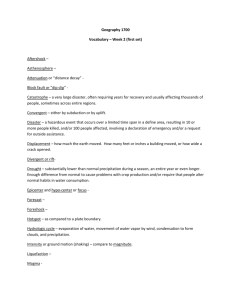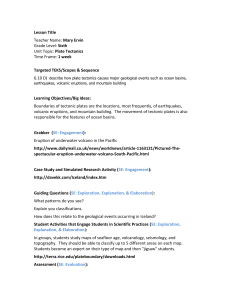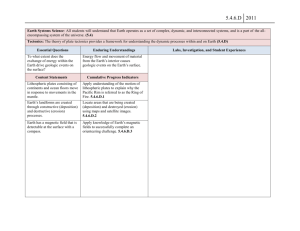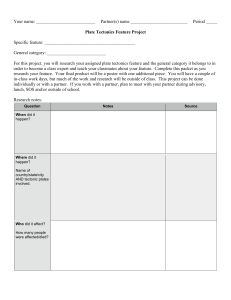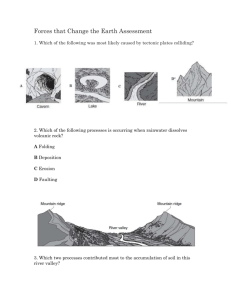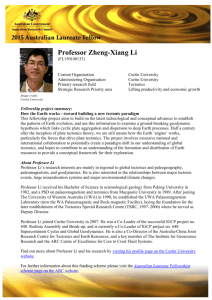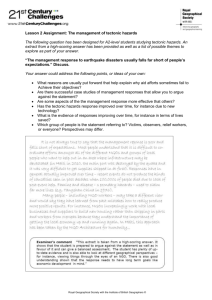Advanced Structural Geology and Tectonics:
advertisement
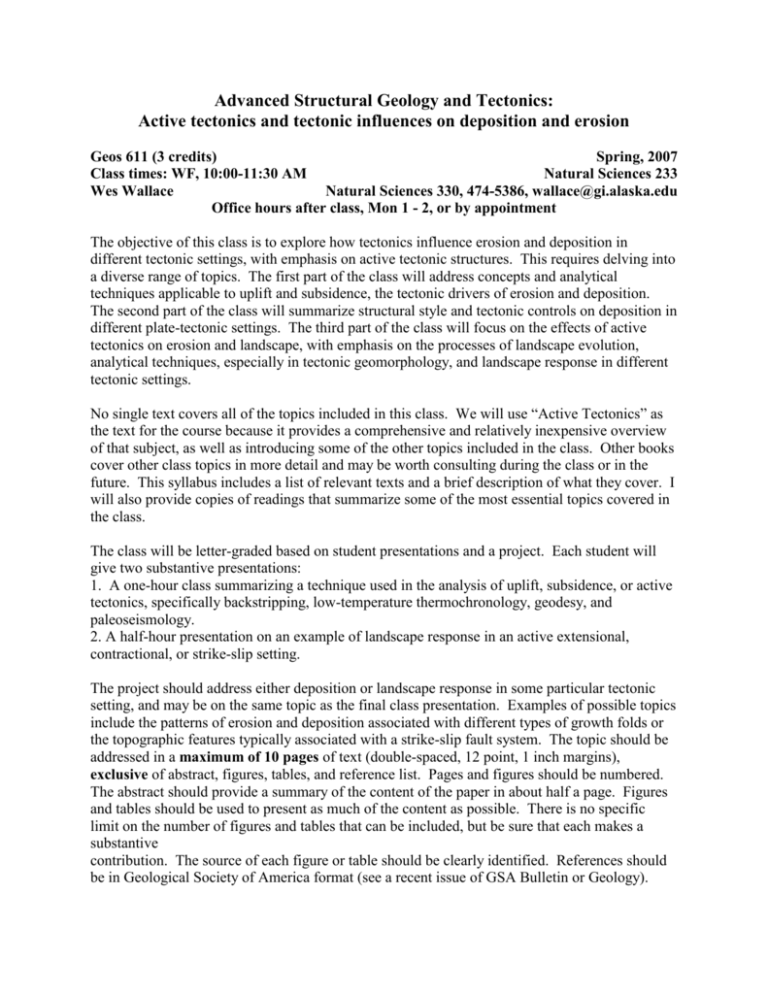
Advanced Structural Geology and Tectonics: Active tectonics and tectonic influences on deposition and erosion Geos 611 (3 credits) Spring, 2007 Class times: WF, 10:00-11:30 AM Natural Sciences 233 Wes Wallace Natural Sciences 330, 474-5386, wallace@gi.alaska.edu Office hours after class, Mon 1 - 2, or by appointment The objective of this class is to explore how tectonics influence erosion and deposition in different tectonic settings, with emphasis on active tectonic structures. This requires delving into a diverse range of topics. The first part of the class will address concepts and analytical techniques applicable to uplift and subsidence, the tectonic drivers of erosion and deposition. The second part of the class will summarize structural style and tectonic controls on deposition in different plate-tectonic settings. The third part of the class will focus on the effects of active tectonics on erosion and landscape, with emphasis on the processes of landscape evolution, analytical techniques, especially in tectonic geomorphology, and landscape response in different tectonic settings. No single text covers all of the topics included in this class. We will use “Active Tectonics” as the text for the course because it provides a comprehensive and relatively inexpensive overview of that subject, as well as introducing some of the other topics included in the class. Other books cover other class topics in more detail and may be worth consulting during the class or in the future. This syllabus includes a list of relevant texts and a brief description of what they cover. I will also provide copies of readings that summarize some of the most essential topics covered in the class. The class will be letter-graded based on student presentations and a project. Each student will give two substantive presentations: 1. A one-hour class summarizing a technique used in the analysis of uplift, subsidence, or active tectonics, specifically backstripping, low-temperature thermochronology, geodesy, and paleoseismology. 2. A half-hour presentation on an example of landscape response in an active extensional, contractional, or strike-slip setting. The project should address either deposition or landscape response in some particular tectonic setting, and may be on the same topic as the final class presentation. Examples of possible topics include the patterns of erosion and deposition associated with different types of growth folds or the topographic features typically associated with a strike-slip fault system. The topic should be addressed in a maximum of 10 pages of text (double-spaced, 12 point, 1 inch margins), exclusive of abstract, figures, tables, and reference list. Pages and figures should be numbered. The abstract should provide a summary of the content of the paper in about half a page. Figures and tables should be used to present as much of the content as possible. There is no specific limit on the number of figures and tables that can be included, but be sure that each makes a substantive contribution. The source of each figure or table should be clearly identified. References should be in Geological Society of America format (see a recent issue of GSA Bulletin or Geology). You should select the topics of your class presentations and project as soon as possible. Please feel free to consult with me about possible topics and sources of information. Advanced Structural Geology and Tectonics (GEOS 611) Active tectonics and tectonic influences on deposition and erosion W.K. Wallace, Fall, 2007 Syllabus, page 2 Class textbook: Keller, E.A., and Pinter, N., 2002, Active Tectonics: Earthquakes, Uplift, and Landscape, Second Edition: Prentice Hall, Upper Saddle River, NJ, 362 p., paperback. ($45.20 list, $38.87 Amazon.com) Basic-level treatment of the effects of active tectonics on the earth’s surface. Emphasizes methods for analysis of active tectonics, especially tectonic geomorphology. Other relevant textbooks: Allen, P.A., and Allen, J.R., 2005, Basin Analysis: Principles and Applications, Second Edition: Blackwell Publishing, Malden, MA, 549 p., paperback. ($92.95 list, $86.44 Amazon.com) Provides a thorough and quantitative treatment of the mechanisms of subsidence and the methods of basin analysis. Presents a summary of sedimentation in different plate-tectonic settings. Burbank, D.W., and Anderson, R.S., 2001, Tectonic Geomorphology: Blackwell Science, Malden, MA, 274 p., paperback. ($74.95 list, $70.45 Amazon.com) In-depth treatment of the effects of active tectonics on the earth’s surface, with emphasis on its analysis using tectonic geomorphology. Busby, C.A., and Ingersoll, R.V., editors, 1995, Tectonics of Sedimentary Basins: Blackwell Science, Cambridge, MA, 579 p., paperback or hardcover. (Currently unavailable new, may be available used) Presents sedimentation in each major plate-tectonic setting in separate chapters by different authors. This is a comprehensive approach, but is somewhat uneven due to the different approaches of the different authors and does not provide separate treatment of the mechanisms of subsidence and uplift. Advanced Structural Geology and Tectonics (GEOS 611) Active tectonics and tectonic influences on deposition and erosion W.K. Wallace, Fall, 2007 Syllabus, page 3 Tentative Class Schedule 1 2 January 17 January 19 3 January 24 4 January 26 Tectonic controls on erosion and deposition: uplift and subsidence Isostasy Stretching and thinning Thermal Flexural Shortening and thickening Landscape response to tectonics Unroofing, rock uplift, and surface uplift Relief vs. mean elevation Base level 5 6 January 31 February 2 7 8 9 February 7 February 9 February 14 10 February 16 11 February 21 12 13 14 15 16 February 23 February 28 March 2 March 7 March 9 17 18 19 March 21 March 23 March 28 20 March 30 21 April 4 22 23 24 25 26 April 6 April 11 April 13 April 18 April 20 27 28 29 30 April 25 May 2 May 4 May 7 Wedge theory Introduction to plate tectonics and basin classification: Structural style and tectonic controls on deposition in different platetectonic settings Divergent Rift Passive continental margin Convergent Subduction complex Forearc basin Arc Intra-oceanic back-arc basin Orogenic belt Foreland basin Strike-slip Pull-apart basin Analytical methods Thermochronology Backstripping Geodesy Paleoseismology Active tectonics The earthquake cycle: recurrence and surface consequences Tectonic geomorphology Rates Landscape response: Rivers, slopes, coastlines Geomorphic indices Landscape response in different tectonic settings Extensional Contractional Strike-slip Advanced Structural Geology and Tectonics (GEOS 611) Active tectonics and tectonic influences on deposition and erosion Fall, 2007 W.K. Wallace Schedule of student-taught classes Presentation one: analytical techniques (one-hour class) 1. Backstripping 2. U-Th/He thermochronology 3 Geodesy 4. Paleoseismology Presentation two: landscape response in an active extensional, contractional, or strike-slip setting (half-hour presentation) 1. 2. 3. 4.
